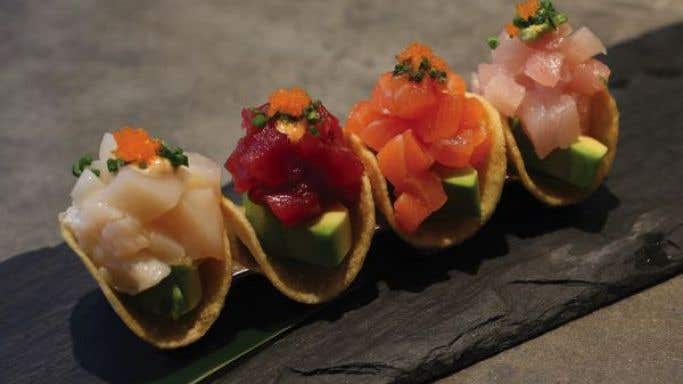A version of this article is also published by the Financial Times.
The most memorable Japanese restaurants, whether serving a formal kaiseki set menu or an informal izakaya, principally a bar with food attached, or a sushi counter, invariably leave me with two sensations very different from those experienced at other restaurants.
The first is a sense of danger. This comes from eating more raw food than I usually do, as well as having the opportunity to watch chefs wielding extremely sharp knives to such beneficial effect at close quarters. The scene late one night at Aburiya Kinnosuke, a favourite izakaya close to New York’s Grand Central Station, as the chefs ceremonially cleaned and gently wiped their long knives at the end of service could have made their kitchen a set for Sweeney Todd.
The second is how much I learn. Most Japanese restaurants provide an introduction to ingredients not on my usual radar and – perhaps more easily transferable to a domestic kitchen – to their chefs’ wonderfully elegant, and often breathtakingly simple, style of presentation.
All these elements – excellent food with increased culinary awareness and danger – came together as we sat at the sushi counter of Dinings, a curiously named jewel of a restaurant in Marylebone.
In fact, I would go as far as to say that seat 106, as it is known to the waiting staff, on the right-hand corner of the sushi counter, is perhaps the most dangerous seat I have ever occupied in any restaurant anywhere.
The interior of Dinings is cramped. An old bow window at ground level lets natural light on to the three sushi chefs who work opposite six customers. At the end of the counter, behind a pair of curtains, is the main kitchen that produces all the hot food as well as the desserts. A steep, narrow curved staircase leads to more tables below, where the ceilings are low (they must originally have been a combination of staff quarters and coal holes).
Seat 106 is at the apex of all this. As the orders come in, the head chef shouts out what he requires from those hidden away. ‘Fire one spider crab’ is an instruction we heard several times. This corner of the glass counter, with the raw fish and summer truffles on display beneath, is also where the finished plates are slid along for collection and delivery by the waiting staff. A great deal of self restraint had to be enforced as beautifully arranged plates of food were displayed no more than a few inches away before being whisked off to other diners.
The backchat was almost as riveting as the food. One waitress, obviously having to deal with regular customers, slipped behind the sushi counter to ask the chef whether she could take an order for a favourite dish that was not on the current menu. Then there was the invariable mix up, as table 3’s sushi was carried down the stairs and then came back up again because it was actually destined for table 2.
Nor was danger ever far away. Seat 106 happens to be next to the stairwell and the waiting staff moving swiftly up and down it. I had to be careful not to turn too quickly for fear of falling down the stairs from my stool, particularly so when I moved it back at the end of a meal that, with a couple of Japanese beers, came to £125 for two.
This meal began with Dinings’ interpretation of the old and the new. First of all came a bowl of miso soup laced with tomatoes and lobster with plenty of diced fresh lobster claw lurking at the bottom of the bowl. Then there was a personal favourite, nasu miso, half a large aubergine marinated in soy sauce that had been cooked so that the vegetable still retained its form but its flesh had become sweet, sticky and a testament to umami’s appeal. It was proof of a belief held by many a chef that aubergine is most successfully cooked as though it were a piece of meat rather than a vegetable. Then came one of the specials of the day written on the blackboards behind the sushi chefs: a sliced scallop, cooked sous vide, served on a white plate with an unctuous black sauce made from seaweed enlivened by a chilli jam. By the time we had fought over it, the remnants on the plate looked like a Rorschach test.
Four different sushi followed. Pieces of o toro, from the rich underbelly of the tuna. As our waiter from Verona served it to us he whispered the chef’s advice not to adulterate such delicate flavour with soy sauce. Two prawns from Santa Barbara, California, sat on the artfully arranged plate with two slices of turbot topped with even thinner slices of truffle and two pieces of eel, whose soft flesh was given extra crunch by a mound of diced cucumber.
Yet the star ingredient in all this was the rice. It had a nutty, succulent quality that delighted us both, a couple hitherto poles apart in their appreciation of this staple. My final memories of our meal were watching my wife fishing for the final grain and hoping that one day I will be able to cook rice at home to the same high standard.
Photographs are courtesy of Charlie Bibby/FT.
Dinings 22 Harcourt Street, London W1H 4HH; tel +44 (0)20 7723 0666


